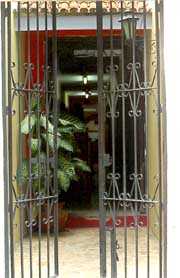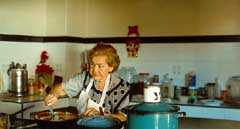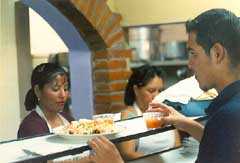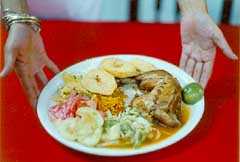
During the day visitors come down the long entranceway that gives this restaurant its name, asking if it is open. Despite the sign at the entrance to El Tunel, showing the opening time 5:30 p.m. they come and ask, and they promise to return in the evening.
Neighbors, too, come throughout the day. In the mornings they come to visit with the family and workers who have begun preparing the evening meal. In the afternoons they come for the caldo, the stock served with the foods on the menu here. They bring plastic containers and cooking pots to carry it home to use as the base for soups and sauces. There is a lot of conversation. Some of these people have known each other for all of the fifty-four years since the restaurant opened here.
El Tunel, Mazatlán’s best known and most popular cenaduria is both a restaurant of choice for visitors and residents of the city and a provider to the neighborhood of two basic ingredients of traditional Sinaloan cooking: caldo and conversation.
Cenadurias (from the verb cenar to have supper/dinner) are restaurants serving a traditional menu that open in the late afternoon and close after 11:30 p.m. or when they run out of food. They are thought locally to have begun in the foothill mining towns of the Sierra Madre Occidental. Originally the extensive preparations were done at home and the foods then were taken to the town plazas where the final cooking and serving was done. The founders of El Tunel began in La Noria, about 30 miles east of Mazatlán, cooking at home and carrying the foods and utensils down a hill and across a small river to the plaza. They cooked on charcoal in those days and it, too, was carried down to the plaza. Some cenadurias served on the streets in front of the houses of the cooks. Later they moved indoors to a room at the front of the house. This is where most of them are found today.

There are as many as twenty cenadurias in Mazatlán. Most serve their immediate neighborhoods. A few are well known and draw from all over the city. They all have the same basic menus but there are individual variations in preparations and taste. Caldos are distinctive.
Asado a la plaza and pollo a la plaza (both served with potatoes and vegetables) are the best-known dishes. Cenadurias also serve tacos dorados, gorditas, tostadas and enchiladas. Tacos dorados (so called because of their golden color) are tortillas folded around meats, beans, potatoes, cheeses or combinations, closed and sautéed. Gorditas use thicker than normal tortillas, which are spread with beans and topped with chicken or beef and covered with vegetables. Tostadas are the same as gorditas except that meat for tostadas is not marinated and sautéed. Sinaloan enchiladas are rolled and sprinkled with grated queso cotija. Pozole, a rich soup based on pork and hominy is the “chicken-corn-soup” of Mexico and is on the menu of all cenadurias. Frijoles are available, sprinkled with queso cotija.
Café de olla, refrescos and waters (jamaica and horchata) make up the drink selection. Raspados are served to diners and for take out. Beer and other alcoholic drinks are seldom found in cenadurias.

The beef and chicken are trimmed and scrubbed early in the day and set to simmer in large pots to start the caldo. Tomatoes and potatoes are added. Whole chickens go in. When fully cooked the meats are removed. The tomatoes and potatoes are removed when done. Preparation continues with the addition of spices and herbs. The caldo is kept hot and stirred from this point on. It is served in small bowls and diners can spoon or pour it onto their food.
Except when making tostadas, the beef and chicken are briefly marinated in salt, vinegar and pepper and sautéed in pure clear lards just before serving. Vegetables are added and the plates with caldo on the side are carried to the tables.
To begin the pozole the corn is boiled with garlic, onion and salt and trimmed and scrubbed pork (including a head) is added to the pot. The pork is removed when it is done. Chile para teñer, a dry red chile, is boiled separately and reduced to puree, the seeds are removed and it is brought to a boil again in water and seasonings. The puree is added to the pozole pot after the removal of the pork and cooked until the corn is done. The pork is added again when the bowls are prepared for serving. It is served with cabbage, onions and other vegetables to be added into the soup according to taste.
An assortment of spices, herbs and chiles are used in cooking and vinegar and oregano have especially prominent places. Vegetables commonly used in Sinaloan antojitos include cabbage, lettuce, calabasitas, carrots, onions, potatoes, and garlic. The vegetables are shredded and chopped. All of the ingredients come together in response to individual orders in a kitchen set in the dining area of the restaurant where five cooks work around a large twelve burner stove with all the ingredients in reach and all the diners in sight.

Preparation of waters begins at midday. Jamaica is made by boiling hibiscus blossoms in water, with sugar and limón mixed in later and with seasonal fruits added to each serving. Horchata starts as separately soaked rice and cinnamon which are mixed together with sugar and vanilla. Both are served with shaved ice in large mugs.
Sinaloan food is ideal for groups with different eating habits and for families. Diners can order combinations of different dishes to match their appetites and tastes. There is a combination for everyone. Children love the food and eating it with their hands.
Service at El Tunel is efficient. Food preparation takes a bit of time since each item is prepared for each order. There is a comfortable and leisurely atmosphere. Folks visit with each other. Some look at the books available for loan or the photographs from Mexican movies hanging on the walls. Classic Mexican music comes from the speakers clearly but at background volume. The bustle, the music, and the activity in the open kitchen visible to everyone give a level of moderate anticipation to the wait for the food.
Cenaduria El Tunel is located on Plazuela Machado in Mazatlán’s Old Town, directly across from the entrance to Teatro Angela Peralta. Doña Jesús Osuna, who came to Mazatlán as a young girl established it at its present location in 1945. Doña Chuy has cooked and served Sinaloan food in Mazatlán for more than seventy years. The restaurant has been in family hands since its founding. The current owner/manager is Doña Chuy’s grandson, Gabino Urrutia. E- mail at [email protected]. The telephone number is 69 826905
After eating, diners drift out into Plazuela Machado, the centerpiece of the revival of Mazatlán’s old town. People congregate in the evenings, walking, talking, sitting on the benches, and waiting for students from the city’s art and music school, which is across the plaza from the cenaduria. A traditional Sinaloan plaza is the setting for this traditional Sinaloan restaurant.
It is a three-block walk to bus lines to the rest of the city. Taxis and pulmonias, Mazatlán’s contribution to public transportation, are available at Plazuela Marchado.
Other interesting cenadurias in central Mazatlán are La Comadre on Avenida Cinco de Mayo, La Copita at the corner of Avenida Zaragosa and Calle Belisario Domingues, and Cenaduria Chayito at the corner of Calle Teniente Azueta and Calle Alejandro Quijano. A small neighborhood cenaduria is located just around the corner from El Tunel; Panchita at the corner of Calle Heriberto Frias and Calle Libertád.
An interesting book on the subject of Sinaloan food is “Sinaloa, Cocina Sin Limites”, by Martha Chapa and Martha Ortiz, photographs by Jorge Pablo de Aguinaco, (1989). It is available from Gobierno del Estado de Sinaloa, Cullicán and at some bookstores including the one at Muséo de Artes in Mazatlán. It is a beautiful book with wonderful photographs and many recipes plus an explanation of Sinaloan cooking. The design is superb. The text is in Spanish. The recipes are easy to read and convert. ISBN 968-6431-00-4.

